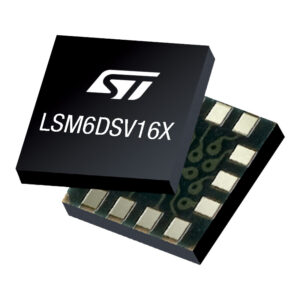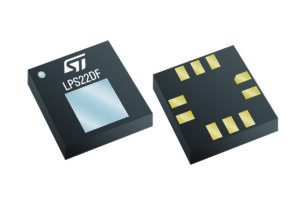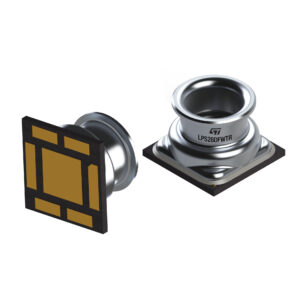Update: April 29, 2024
ST recently released the LSM6DSV32X, which is nearly identical to the LSM6DSV16X but features a 32g accelerometer, thus opening the door to asset tracking, free fall, and shock detection applications that require a greater range of motion. It still features a finite state machine and machine learning core, among other things. The power consumption values are also similar, meaning that engineers get all the benefits of the previously launched device but can qualify one component for more use cases.
Original publication, March 9, 2022
ST is launching a new series of sensors that offer a greater performance-per-watt ratio, starting with the LSM6DSV16X, the latest member of our family of inertial MEMS with a machine learning core. Following the LSM6DSOX and LSM6DSRX, the LSM6DSV16X is more accurate than the former and uses less energy than the latter. Moreover, it’s the first time such a device has offered Qvar sensing to measure quasi-electrostatic potentials. We are also announcing the industry’s first dual full-scale pressure sensors. The LPS22DF and the LPS28DFW feature a low consumption of only 1.7 µA and an absolute accuracy of 0.5 hPa. Finally, the LIS2DU12 is a three-axis accelerometer consuming only 0.45 µA.
LSM6DSV16X
The Need for More Efficient Inertial Sensors
The image quality of phone cameras continues to improve, but manufacturers still struggle with image stabilization. Many use software to improve the overall sharpness. However, a physical image stabilizer still yields the best results. In this scenario, an inertial MEMS senses the camera’s movement, and the image sensor shifts in the opposite direction to compensate. The problem is that smartphones’ tight enclosures and energy restrictions can limit what inertial MEMS can do. AR and VR headsets also thirst for more efficient sensors. Accuracy is critical when tracking head or hand movements. Indeed, an accurate and fast sensor provides a more realistic experience and can even mitigate VR sickness. However, the rise of battery-powered models comes with great energy constraints.
The problem when trying to design energy-efficient inertial sensors is that engineers hit a physical dilemma. To improve performance, designers often try to lower the signal-to-noise ratio with filters and other mechanisms but these automatically increase power consumption. Hence, since every watt counts in a smartphone, designers often struggle between a better stabilizer or a better battery life. Additionally, MEMS must also use a small package. Designers can’t improve accuracy at the cost of a larger footprint.
0.65 mA in low power mode

The LSM6DSV16X solves this problem thanks to new springs in its mechanical portion. Additionally, ST trimmed the amplifier’s gain to keep the power consumption low despite an improved performance. Hence, the LSM6DSV16X uses 0.65 mA in high-performance mode (gyroscope and accelerometer combined) compared to 1.2 mA for the LSM6DSRX, despite both devices having a similar noise level in low power mode. Engineers working on optical image stabilizers for smartphones no longer have to choose between performance and power consumption. Comparatively, competing devices often have a low power consumption that’s twice as high, if not more.
An MLC 2x Faster and an Adaptive Self-Configuration (ASC)
Another feature that helps save energy is the machine learning core (MLC). By running the sensor’s information through the decision tree, developers avoid waking the microcontroller, significantly reducing overall consumption. The LSM6DSV16X provides an MLC that’s twice as fast as the one found on its predecessors with an output data rate (ODR) going from 100 Hz to 240 Hz. As a result, engineers can process more data for a given period and thus save more energy.
Users also get the 16 finite state machines (FSMs), which help recognize specific patterns. Moreover, the new device uses adaptive self-configuration which allows the FSMs to reconfigure themselves without waking the MCU. Hence, developers can program various conditions and contexts that would trigger a reconfiguration, thus allowing a greater degree of flexibility. Finally, both MLC and FSMs can also inform each other to create smarter applications capable of tracking physical activities more accurately or whether a smartphone is placed face down, among many others.
Qvar

The LSM6DSV16X introduces Qvar to the LSM6 family of devices. In a nutshell, engineers only need to connect two electrodes to measure variations in quasi-electrostatic potential and change two registers to enable the feature. Qvar opens the door to new applications, such as people counting. Instead of using an LED and photodiode, engineers can place electrodes on walls and measure if someone walks near them. We even wrote an application note to help designers develop a demo. Additionally, ST will introduce new use cases by the end of the year. The LSM6DSV16X remains pin-to-pin compatible with the other members of the LSM6DS family thanks to a pin-sharing mechanism between Qvar and the test pin.
LPS22DF and LPS28DFW
The Problem with Sensing a Body of Water

With the advent of activity tracking, pressure sensors must adapt to a much broader array of physical settings. From mountain climbing to swimming, the sensors must reliably track the user to provide accurate information about their physical activity. The problem is that climbing a hill or stairs is an entirely different scale than swimming in a pool as the body of water exerts a very different pressure. For instance, diving under 10 meters of water exerts a pressure of 14.5 PSI, the same atmospheric pressure at sea level. Hence, pressure sensors must account for very different conditions without blowing up the power consumption.
9.1 µA and 7 µA

The LPS22DF and the LPS28DFW solve this issue by being the first pressure sensor with two full-scale. Hence, the device can detect whether the user is above or below water and switch to one of its two scales. The LPS22DF supports a maximum pressure of 1,260 hPa, and the LPS28DFW goes up to 4000 hPa while both consume 9.1 µa and 7 µA in high-performance mode respectively. Comparatively, the LPS22HB needs 12 µA for a maximum of 1260 hPa. The gains in efficiency are even more essential when considering that these sensors are very likely to end up in wearables.
LIS2DU12
The LIS2DU12 is a new compromise between performance and energy consumption. Thanks to its new LC pass filter and anti-alias filter, it is more accurate than the previous generation. The former will reject electrical noise while the latter prevents sampling errors. Hence, both vastly improve the quality of the signal but do not drastically increase the power consumption. The previous generation LIS2DW12 only needs 380 nA in low-power mode while the new and more accurate LIS2DU12 clocks at 450 nA. Comparatively, competing products tend to hover at 1 µA.
